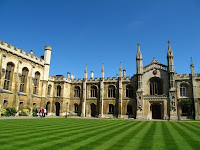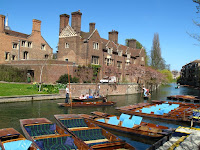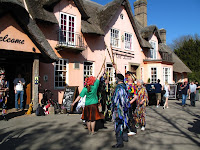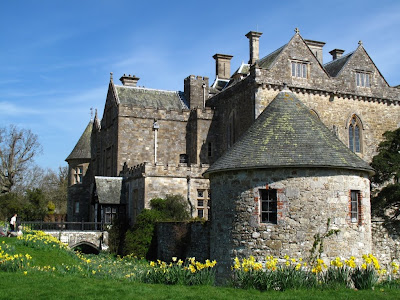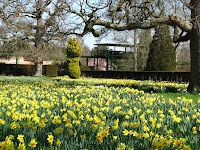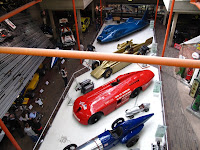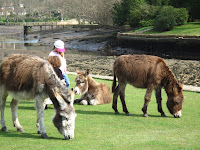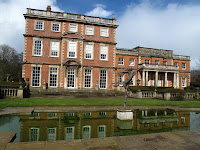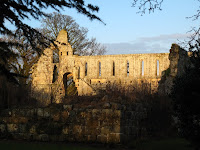

Today we joined the annual MG picnic at Arundel Castle. It was a lovely day, and by the end of the morning, the lawns below the castle, were overflowing with MG's.

Arundel Castle was first built on 1067, and the Keep which is open to the public, is part of that original castle building. The castle proper was rebuilt in Victorian times, after it had lain ruined since the Civil War in the 17th century, and is an amazingly dramatic building, everything is on a generous scale.

Most rooms are rather austere, but the Drawing Room is a blaze of colour and has a welcoming feel. The private chapel is very beautiful, with marble columns, but the most dramatic and appealing room in the house, is the Library. It can hardly be called a room, as it is a series of long rooms, with rich carved mahogany panels, cabinets for books, rich red carpets and curtains. The fireplaces in nooks off to the side of the library made you wish you could spend a winter's day relaxing there with a book. It is said to be the best such private library in England.

In the grounds is one of the more unusual churches we have visited in England. Back in Henry 8th's day, it was decreed that the church had to be given to the new Church of England. But the Duke of Norfolk argued that his ancestors were buried there, so as a compromise, the church was divided in two. Half is the Arundel Parish Church of England and used for normal services, the other half can only be entered from the grounds of Arundel Castle, and is still Catholic. It is full of huge and ornate tombs of the Norfolk ancestors.
The grounds were complimented by the new ''Collector Earl's Garden”, which opened in 2008. It is a lovely tranquil, but dramatic area, which will be even more stunning in another week's time, when the tulips are open.

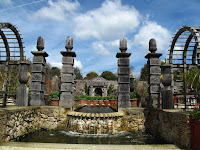

After a relaxed day admiring the MG's, exploring the castle and the very attractive town, we decided to call into Petworth House on the way back to London. Every room open to the public is covered with works of art by Titan, Turner, Van Dyke, Lely, Cyup among many others, including one by Hieronymus Bosch.

After Arundel, where the Victorian Castle still seems crisp and new; Petworth would appear very jaded and tired, were it not for the stunning array of artworks. The highlight of the collection is in the Carved Room. Here the entire huge room is filled with old masters in wall to wall carved wooden frames. Half the room was carved by the famous carver Grinling Gibbons, and this was then copied in the remainder of the room. Pride of place in the centre of the long wall, above the fireplace is a painting of Henry 8th. Under all the large paintings are seascapes by Turner, which are almost overlooked in the overall splendour of the room.

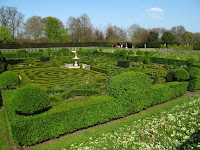 After a relaxed start to the day, we set off with a picnic lunch to enjoy a day our in our classic car, only to have it die on us, as seems to be the way with our particular historic car. But as it was such a lovely day, we still set out on our picnic after the AA got us going well enough to return home and swap cars.
After a relaxed start to the day, we set off with a picnic lunch to enjoy a day our in our classic car, only to have it die on us, as seems to be the way with our particular historic car. But as it was such a lovely day, we still set out on our picnic after the AA got us going well enough to return home and swap cars.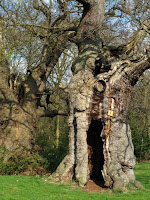 Our destination, Hatfield House, was definitely worth driving to, even though we had a mid-afternoon picnic lunch. Only 30 minutes from home, it feels like a few centuries away. This house has seen so much history. Built in Tudor times by Lord Cecil, the Chancellor, it was home to Elizabeth I for much of her childhood. At the end of the afternoon, we did a walk through the 1,000 acre grounds, past the spot where, in 1558, Elizabeth was given the news that she was now the Queen.
Our destination, Hatfield House, was definitely worth driving to, even though we had a mid-afternoon picnic lunch. Only 30 minutes from home, it feels like a few centuries away. This house has seen so much history. Built in Tudor times by Lord Cecil, the Chancellor, it was home to Elizabeth I for much of her childhood. At the end of the afternoon, we did a walk through the 1,000 acre grounds, past the spot where, in 1558, Elizabeth was given the news that she was now the Queen. The house still has an original feels inside, which doesn't mean it is run down in a 600 year old look, but rather that the Tudor interiors have been carefully preserved and it still looks magnificent today.
The house still has an original feels inside, which doesn't mean it is run down in a 600 year old look, but rather that the Tudor interiors have been carefully preserved and it still looks magnificent today. The house is complimented on three sides by perfectly maintained formal gardens. Only the West Garden is open on weekends, but is a real treat to wander through this expansive garden. The woodland walks have been a mass of daffodils, now finished, but in the woodland beyond the West Gardens, the daffodils are still in perfect condition.
The house is complimented on three sides by perfectly maintained formal gardens. Only the West Garden is open on weekends, but is a real treat to wander through this expansive garden. The woodland walks have been a mass of daffodils, now finished, but in the woodland beyond the West Gardens, the daffodils are still in perfect condition.

